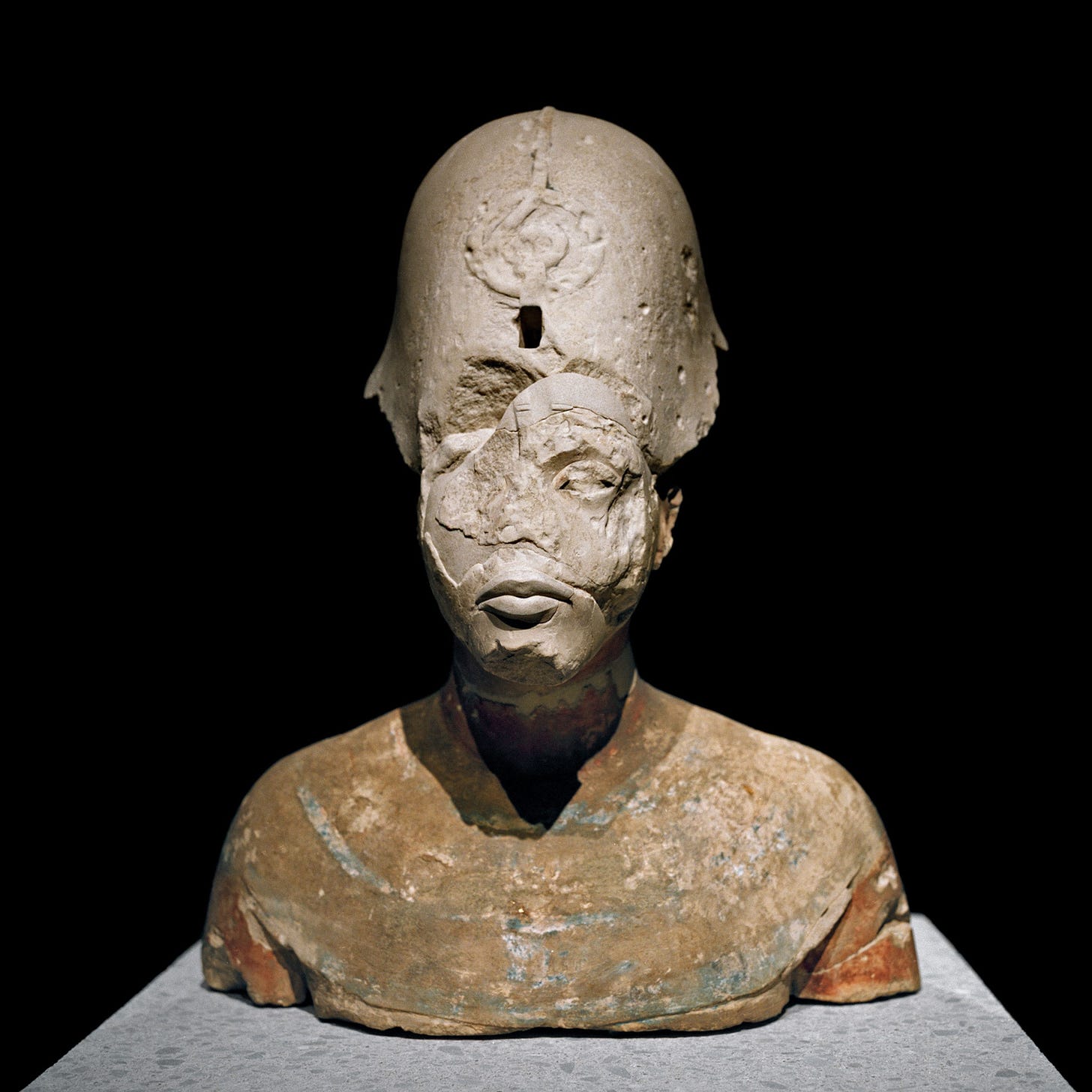#45: They say your sons are many, so give me one son of yours!
Ankhesenamun, the Ancient Egyptian queen with an unorthodox request
Hey, I’ve got a riddle for you. What do you get when you cross a spoonie, tromping 17000 steps a day across Rome, plane rides, and a heat wave?
One sick human, that’s what!1
However, as any chronically ill baddie’ll tell you, certain things are worth getting knocked on your ass for. Rome, my friends, was one of them. Ancient history is my favorite thing to research in my spare time. When I was a kid, I’d play PC classics like Caesar III and Pharaoh til my eyes burned. In sixth grade, I wrote the name tag for my desk in hieroglyphics2. So you can imagine my unbridled enthusiasm as Rhody and I wandered the Forum, marveled at the horrors of the Coliseum, and ogled the art at the Vatican3.
But exploring ancient history museums in Europe is complicated. On one hand, what a marvel to see the ephemera of ancient life on display - a bowl, a sarcophagus, a clay tablet detailing the sale of a tract of land!
On the other, Europe’s theft of these treasures is a modern tragedy, robbing countries of their own histories… all so European cities can benefit from the tourism these ancient artifacts generate.
Juggling that duality of awe and squidge, I wandered the Vatican’s Ancient Egypt exhibit, bathing in the opulence and getting amped as hell to write this month’s newsletter.

📚Ancient Egypt, lost in space(time)
Researching Ancient Egypt is no easy task.
Kind of like the shifting sands surrounding their monuments, Ancient Egypt’s history is slippery, the truth evading our grip before we get a wrangle on it.
Picture for a moment that you’re standing in Egypt a thousand years ago, at the foot of the Sphinx, looking straight up. Your neck hurts from craning, but why wouldn’t you? All around you, there are stories tucked inside millennia, history right there… and you have no way to learn its secrets.
That’s how things were for centuries. Because, despite the kingdom of Ancient Egypt carving their stories onto walls, obelisks, and tablets galore, by the year 400 CE, the entire world had forgotten how to read hieroglyphics.
As the centuries passed, Egypt’s ancient cities were pillaged by invaders, ruined by the elements, and all around forgotten until the rediscovery of the Rosetta Stone, which had unceremoniously been used a a stone to build a fucking fort in the 1400s4 and not recognized as a world-changing translation key until the 1800s.
This is all to say that, these juicy letters we’re about to read, this story of a queen who casually asked a neighboring country’s king to send her a son?
Scholars can’t agree on which frickin’ queen it was.
The general timeline narrows the queen’s identity down to three key contenders: Meritaten (who might’ve been a pharaoh at some point herself, but scholars ain’t even sure about that), Nefertiti, famed for her beauty…
Or the most likely candidate of all based on the circumstances in the letter - Meritaten’s sister, Nefertiti’s daughter:
⚱️ Ankhesenamun
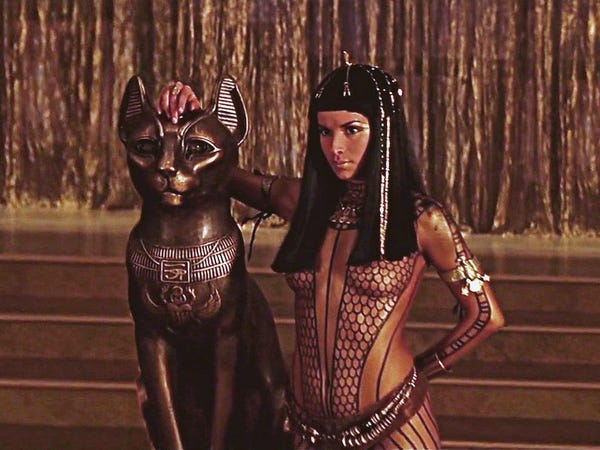
Out of these three women, none tangoed with tumult quite like Ankhesenamun. From a young age, she was groomed to marry a man of power, and is even postulated to have had a child… with her father… by the age of thirteen. From what I understand about royal ancient families, I guess this was kind of normal at the time5? Research on this point, again, is nebulous.
What’s certain is that her father Akhenaten - more on him later - was a chaotic king later branded as “the criminal” by the pharaohs that came after him, and that chaos informed Ankhesenamun’s early life.
But she had one bright spot, someone she loved with all her heart. Her half-brother - and husband - a dude you’ve no doubt heard of: King Tutankhamun6.
👩🏽❤️👨🏽 A family affair
Putting aside our own contemporary taboos for a minute, back then, it was the norm for royalty to keep it in the family7.
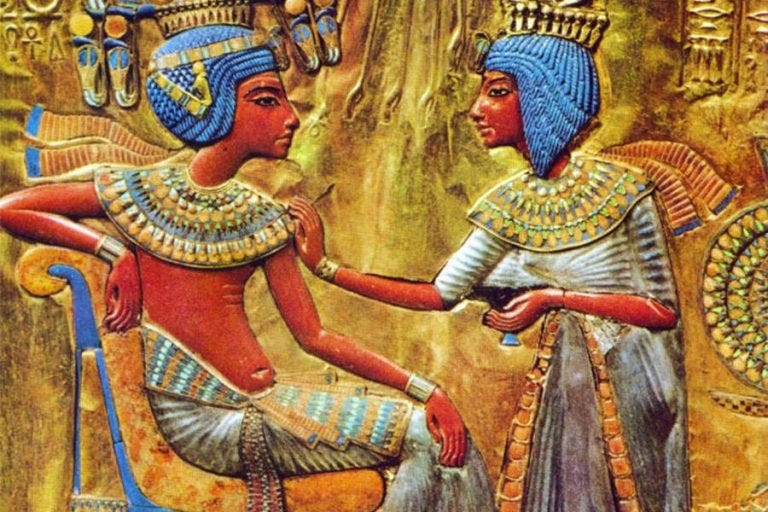
Ankhesenamun and Tut may have been half siblings, but their love for each other is something many scholars agree on. Look at the image above and consider what Egyptologist Zahi Hawass’ book The Golden King: The World of Tutankhamun8 has to say about some of the imagery found in Tut’s tomb:
“To judge from their portrayal in the art that fills the golden king's tomb… We can feel the love between them as we see the queen standing in front of her husband giving him flowers and accompanying him while he was hunting.”
But their love was no match for tragedy - or genetics. Tutankhamun and Ankhesenamun had two daughters who, likely because of their parents’ shared gene pool, were born prematurely and died. Millennia later, both daughters’ mummies were found alongside Tutankhamun in his tomb.
Tragedy of their loss aside, because the two loved each other, it may have seemed like they’d found a slice of happiness. But Tutankhamun is called “the boy king” for a reason: Tut died at just nineteen years old.
And, still a kid herself and now a widow, Ankhesenamun was left out to sea, no heir in sight, with power hungry pseudo-allies nipping at her ankles. The country was already in disarray from the ripples of her chaotic father.
With her claim on the throne intact for only as long as she could carry on the dynasty’s genes, what’s a girl to do? All of twenty and scared shitless, Ankhesenamun reached out to her neighbors asking for a little favor.
💍 Hey, pal, gimme your son
In Ancient Egypt, women could be Pharaoh, own businesses, get divorced, lend money, own property - you name it, they did it. Sure, there were gender roles and gendered positions (like weaving or brewing, both traditionally done by women), but compared to the patriarchal swamp women have waded through in other empires, Egypt was fucking peachy.
Even so, nothing was more important than an heir. Men had the right to divorce a spouse who couldn’t provide them with a kid9. As Egypt’s ruler, Ankhesenamun wasn’t immune to this pressure, and her position was tenuous.
On top of grieving for Tut and being afraid of what came next, Ankhesenamun’s father’s uncle, Ay, was gunning for the throne (imagine the age gap) and trying to get our girl Ankhesenamun to marry him. Gross.
If that weren’t enough, people were still unhappy with her father’s legacy. And Egypt was juggling intermittent skirmishes with their neighbors, the Hittites. Even before Tutankhamun’s death, tensions between the Hittites and Egypt were on the rise.
Can you imagine Ankhesenamun’s desperation? No more than twenty, and freaked out, everyone salivating to nab your power at any cost?
I don’t know about y’all, but when I was her age, I wasn’t managing a kingdom. I was swamped with other pressing matters, like how to best juggle full-time work and full-time studies with day drinking on lazy rivers and posting unflattering party pics on Facebook. Having people watch my messy 19-year-old life unfold online was hard enough.
It’s no wonder Ankhesenamun sent a letter to the king of the Hittites, past skirmishes be damned, asking for their help… in the form of a hunky10 and available son.
While the original letters have been lost, one of Hittite King Šuppiluliuma I’s sons, Mursili II, recorded the entire exchange on clay in what’s now called The Deeds of Šuppiluliuma.
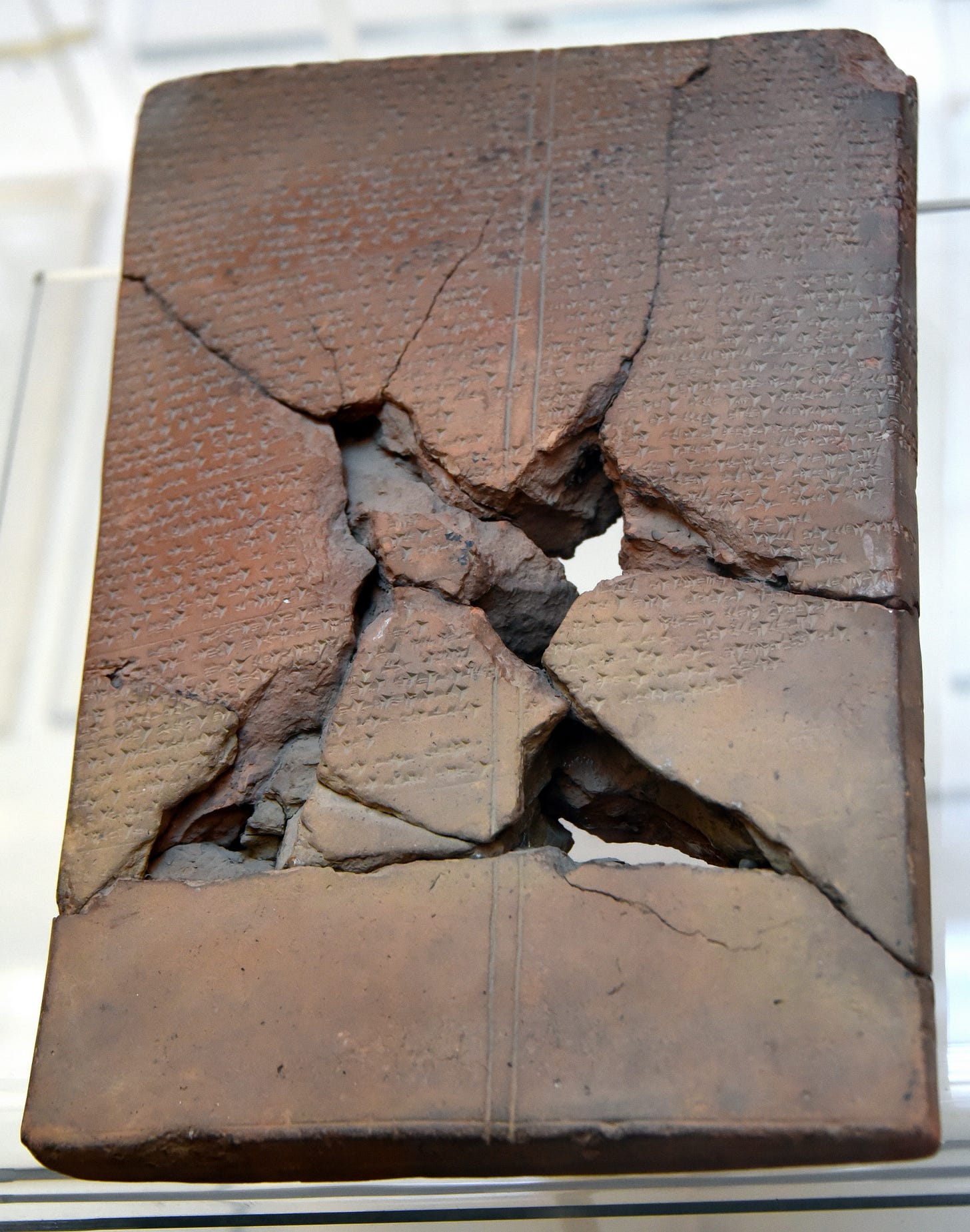
According to Mursili II’s transcription11 Ankhesenamun kept her first letter short and sweet:
My husband died. I have no sons; people say you have many. If you send me one of your sons, I’ll make him my husband. I’ll never choose a servant [or subject] of mine to be my husband12…
I am afraid.
If that frank fear doesn’t have you gutted for our young queen, I don’t know what will.
🗺 Hittites hit back
Ankhesenamun’s letter wasn’t usual. Egypt was powerful, despite the chaos, and these regions weren’t exactly pals. So to have a queen casually send out, “Yo, gimme one of your sons, thanks” to a neighboring King they’d recently skirmished with sounded about as wild to the Hittites as it does to us today.
Šuppiluliuma, confused as hell, got his council together for advice, musing, “Such a thing has never happened to me in my whole life!”
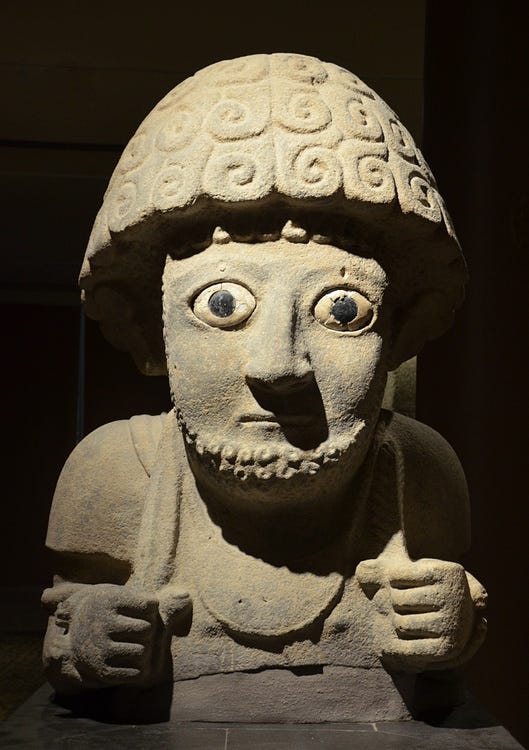
Naturally, Šuppiluliuma had suspicions. Why would a queen of a country he had beef with want to marry one of his sons? He sent a messenger along to glean more information, including a letter destined for the queen that said, among other things:
Maybe they deceive me! Maybe their ruler has a son already…
Y’all, this wasn’t a quick missive. These letters (which were actually clay tablets) likely took weeks to make it into one another’s hands. Can you picture Ankhesenamun’s anxiety as she waited (I am afraid) - and the utter disappointment to receive a letter that’s not filled with “yes hi here’s my son btw he’s hot” and instead asking, “are you a lying jerk?”
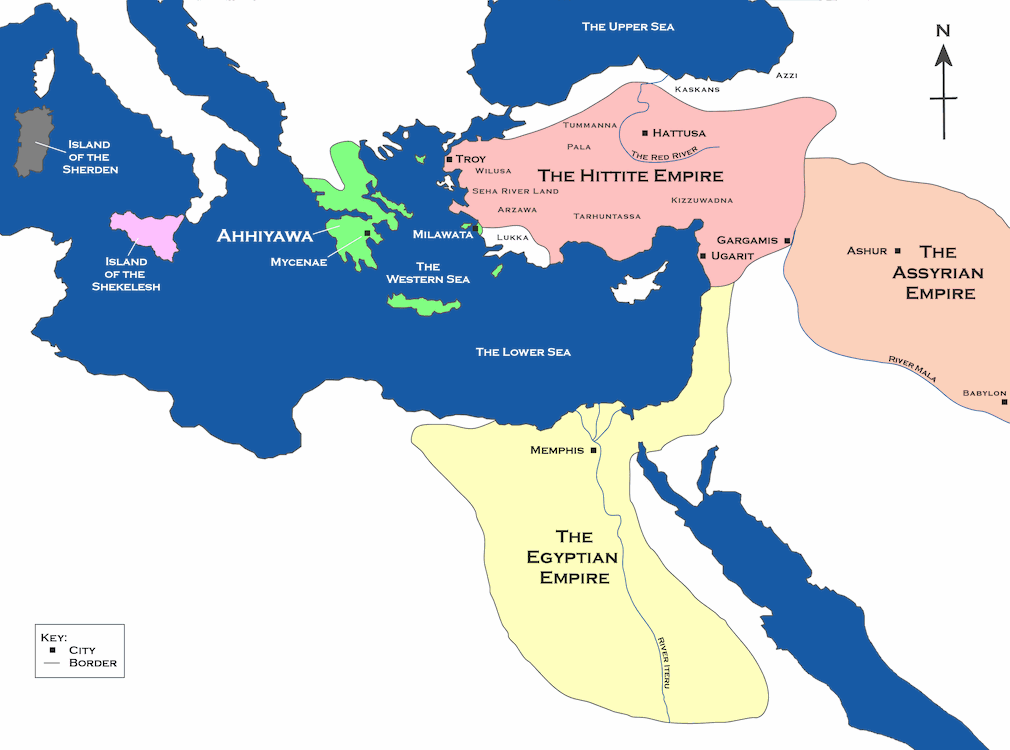
When she wrote her response, I like to imagine Ankhesenamun scribbling away on papyrus or stabbing at a clay tablet, as angry as Veronica in Heathers, but in reality, she probably had a scribe transcribe her salty-ass response:
Why did you say “they deceive me” in that way? Had I a son, would I have written about my own [lack of one] and my country’s shame to a foreign land? You don’t believe me and have spoken… [so badly] to me!
My husband has died. A son I have not, and I shall never take a subject of mine and make him my husband! I have written to no other country; I have only written to you!
Still, angry as she was (peep the insane amount of exclamation points), Ankhesenamun doubled down on her original pitch:
They say your sons are many, so give me one son of yours! To me he will be husband, but in Egypt he will be king.
This tablet-letter made its way back into Šuppiluliuma’s hands. Who knows what swayed him next - maybe he was genuinely sympathetic to the young queen, or maybe curiosity was enough.
Either way, our record is a biased one. Mursili II’s love and esteem for his father colors our knowledge of events, especially because Mursili II summed up Šuppiluliuma’s next move in one sentence13:
So, since my father was kindhearted, he complied with the word of the woman and concerned himself with the matter of a son.
Sending a son was a move Šuppiluliuma would come to regret.
🛡 The Zannanza Bonanza
Šuppiluliuma chose his son Zannanza, sent him on his way, and hoped for the best - a diplomatic, permanent tie between the Hittites and the Egyptians, that would bring an end to their skirmishes.
Only, that didn’t happen. Instead, our boy Zannanza, who was slated to become the Pharaoh, was killed before he even made it fully into Egypt.
Understandably, Šuppiluliuma was pissed. He sends his kid out in a gesture of good faith, and he’s murdered almost immediately, with no concrete evidence as to whodunit?
Much like diplomatic incidents today, the truth got lost in a barrage of he said, she said. Even back then, it seems like nobody had the truth in hand. Add the sands of nearly four thousand years onto that, and modern interpretations of what happened are educated guesses at best. All we know for sure is that someone killed Zannanza, ending any hopes of a peaceful joining of empires.
After that, things escalated quickly, ending in the Hittites launching an attack against Egypt. In the skirmish, they captured some Egyptians, and these prisoners then (as comeuppance? A curse? Rotten coincidence?) spread a plague throughout the Hittite population14.
After that, shit ends tragically for Ankhesenamun. She was largely scrubbed from the record, but historians are fairly certain that she became a second wife of Ay (the creepy great uncle), who took the throne as Pharaoh and ruled for four years before meeting an early end15.
After that marriage, no evidence of Ankhesenamun remains. I like to picture her on a boat along the Nile, enjoying a fake new life as a brewer or delivery person, growing old free from the machinations she was born into. The truth, I fear, must have been infinitely lonelier for our young queen.
🌕 WTF was happening? The brief and terrible reign of monotheism, that’s what.
For most of Ancient Egyptian history, polytheism was the mainstay. They legit worshipped a god for everything - like Tjenenet, the goddess of brewing beer, or my favorite for its specificity, Dedun, the god of goods from Nubia - present-day Sudan16.
However, right before Ankhesenamun was born, her father Akhenaten took it on himself to reshape Egypt’s religion, declaring the existence of one “true” god: Aten, a sun disc deity closely associated with the power of the Pharaohs.
This was the first time in recorded history that a culture opted for monotheism, and you can imagine how well the people took the news. This is a hotly debated time in Ancient Egyptian history, but Akhenaten’s motives were likely money-based. Although Egypt was a thriving polytheistic empire, the cult17 of Amun (another god) held more influence than any others. The priests and temples of Amun had wealth and influence to rival royalty, and owned more land than the Pharaoh himself.
Pissed, and perhaps scared of losing full control of the empire, Akhenaten declared monotheism. He closed all temples not devoted to Aten and chiseled the names of other gods from monuments, forbid his subjects from worshipping other gods, and conveniently told everyone that the Pharaoh was the only true conduit between Aten and the masses. To add insult to injury, he moved the kingdom’s capitol from Thebes to the newly-constructed city Amarna (also called Tell Al-Amarna), all to focus on praising Aten - and keeping the Pharaoh’s own coffers fat18.
Up to this point, Ancient Egypt didn’t even have a word for religious tolerance; they’d just let people worship who they wanted. For this to happen essentially overnight because one Pharaoh decreed it? People complied begrudgingly, waiting for the time when Akhenaten’s reign would end.
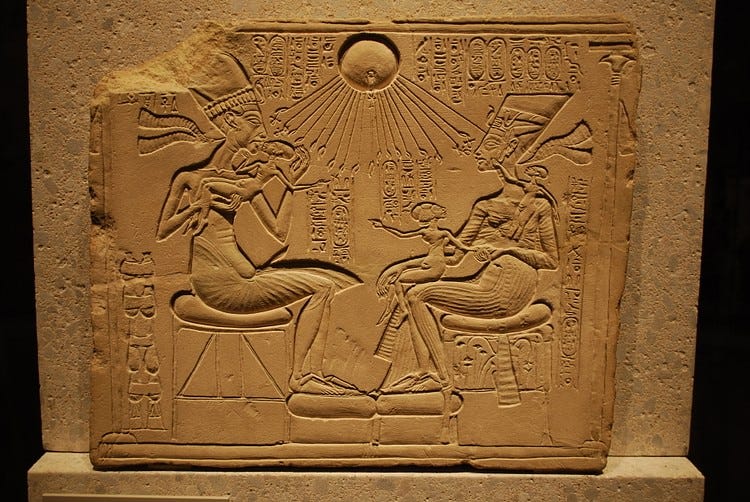
After seventeen years of Akhenaten’s reign, he died, and things moved quickly from there. His children distanced themselves from his monotheistic fervor almost immediately. In fact, our queen Ankhesenamun was actually born with a different name: Ankhesenpaaten, which means “She Lives for Aten.” Tutankhamun did the same, changing his name from the original Tutankhaten.
Only two years into Tut’s reign, he moved the capitol from Amarna and back to Thebes. In a public decree, Tut described the Kingdom under his father’s reign like this:
“The land was in distress; the gods had abandoned this land.”
For generations, the next few pharaohs worked hard to destroy any statues and images of Akhenaten, eager to wipe him off the historical record19.

Akhenaten’s monotheistic push was short-lived. Like anyone who’s tried to nickname themselves something cool like “Ace” will tell you, you can’t force something like this into existence; it’s gotta happen on its own. After Ankhenaten died, people quickly abandoned the city of Amarna, left the monotheistic hoo-ey behind, and returned to their old ways - gods of Nubian goods and all20.
Some quick good news
I’m PARTICIPATING IN A PANEL at WorldCon in Glasgow next month! With the combination of traveling to Scotland and being sick this month, I’ll be releasing this topic’s voting and microfiction a little off schedule; we’ll go back to normal programming in September.
And speaking of my novel… Do y’all recall that novel contest I was a finalist for all the way back in February? I won it alongside fellow writer Charity Tahmaseb! If the editors found two books they loved, why make them choose :). I’m over the moon about Pulp Literature’s review of The Year We Got Away:
“We just loved this quirky novel… Double exposures (emphasis on exposure) are about dual identity — what was historically acceptable and unacceptable. And traditional labels don’t do justice to the complex layers of Dot’s sexuality. This genre- and gender-bending historical novel is a stunning debut!”
Excuse me while I get that tattooed backwards on my belly so I can see it every time I gaze into the mirror.
Thank you for going down ancient memory lane with me, folks. I can’t wait for this session’s microfiction!
All my love and saucy cuneiform tablets,
Nikita, your Snail Mail Sweetheart
It’d take nothing less than travel, the flu, and a fibro flare to knock this newsletter of schedule.
Yes, I was a nerd. No, I didn’t have many friends. Yes, only 4 people signed my year book in 8th grade - and one of them was the guidance counselor. No, I wouldn’t change a dang thing.
I didn’t sizzle upon entry!!!
The Life of Napoleon Bonaparte, Volume 1 by William Henry Ireland
Obviously “normal for the time” and “not horrifying at all” are two very different things.
The Golden King: The Book of Tutankhamun by Zahi Hawass
*sweats in post-hysterectomy*
I may have embellished here. She never said hunky. But we can hope she was thinking it. She deserved to dream big!
All the following transcriptions are modernized translations from one source: ”The Deeds of Suppiluliuma as Told by His Son, Mursili II” as translated by Hans Gustav Güterbock in the Journal of Cuneiform Studies, Vol. 10, No. 3 (1956)
Totally referencing her uncle here, among other people.
Question - do you think this cuneiform tablet is like an early gossip mag? Mursili II sitting there furiously scratching out all the hot goss, transcribing the letters, so everyone can know just how weird the past year was for the Hittites? I’d like to think so. After all, we already know by now how petty ancient cultures could be.
Cult doesn’t mean the same thing here as it does today. In this case, it’s the group of key worshippers/temples/priests designated for a certain god - not Heaven’s Gate cult of matching tennis shoes.
Basically all information on Atenism I gleaned from Myths and Legends of Ancient Egypt by Lewis Spence and "Akhenaten" by Joshua J Mark for World History (again).





